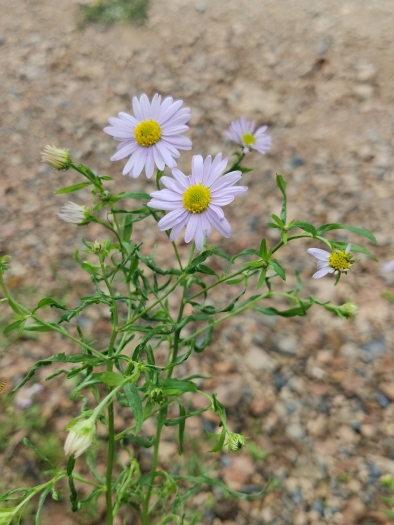East Asian Aster
(Aster lautureanus)
East Asian Aster (Aster lautureanus)
/
/

Elena_Sherehora
CC BY 4.0
Image By:
Elena_Sherehora
Recorded By:
Copyright:
CC BY 4.0
Copyright Notice:
Photo by: Elena_Sherehora | License Type: CC BY 4.0 | License URL: http://creativecommons.org/licenses/by/4.0/ | Rights Holder: Elena_Sherehora | Publisher: iNaturalist | Date Created: 2023-09-04T13:33:56-07:00 |

Estimated Native Range
Summary
Aster lautureanus, commonly known as the East Asian Aster, is a perennial herb native to a variety of habitats including forest margins, grasslands, and along streams in East Asia, specifically China, Korea, and Asiatic Russia. It can reach up to 40 inches in height and is known for its daisy-like flower heads, which feature a central cluster of yellow disc florets surrounded by blue to violet ray florets. The blooming period occurs in late summer to early fall, and the flowers are quite showy, attracting pollinators such as bees and butterflies.
The East Asian Aster is valued for its late-season blooms, which add color to the garden when many other plants have finished flowering. It is commonly used in border plantings, wildflower gardens, and as a cut flower due to its attractive blossoms. This plant prefers full sun to part shade, moist but well-drained soil, and is relatively low maintenance once established. While generally disease-resistant, it can be susceptible to powdery mildew in humid conditions. It is not known for aggressive roots or significant invasiveness, but deadheading can prevent unwanted self-seeding.CC BY-SA 4.0
The East Asian Aster is valued for its late-season blooms, which add color to the garden when many other plants have finished flowering. It is commonly used in border plantings, wildflower gardens, and as a cut flower due to its attractive blossoms. This plant prefers full sun to part shade, moist but well-drained soil, and is relatively low maintenance once established. While generally disease-resistant, it can be susceptible to powdery mildew in humid conditions. It is not known for aggressive roots or significant invasiveness, but deadheading can prevent unwanted self-seeding.CC BY-SA 4.0
Plant Description
- Plant Type: Herb
- Height: 1.5-2.5 feet
- Width: 1.5-2.5 feet
- Growth Rate: Moderate
- Flower Color: White
- Flowering Season: Summer, Fall
- Leaf Retention: Semi-deciduous
Growth Requirements
- Sun: Full Sun, Part Shade
- Water: Medium
- Drainage: Medium, Fast
Common Uses
Border Plant, Butterfly Garden, Low Maintenance, Potted Plant
Natural Habitat
native to a variety of habitats including forest margins, grasslands, and along streams in East Asia, specifically China, Korea, and Asiatic Russia
Other Names
Common Names: Japanese Aster
Scientific Names: , Aster lautureanus, Aster asterellus var. stenolobus, Asteromoea lautureana, Boltonia lautureana, Boltonia lautureana var. lautureana, Kalimeris lautureana, Kalimeris lautureana subsp. lautureana, Kalimeris lautureana var. lautureana,
GBIF Accepted Name: